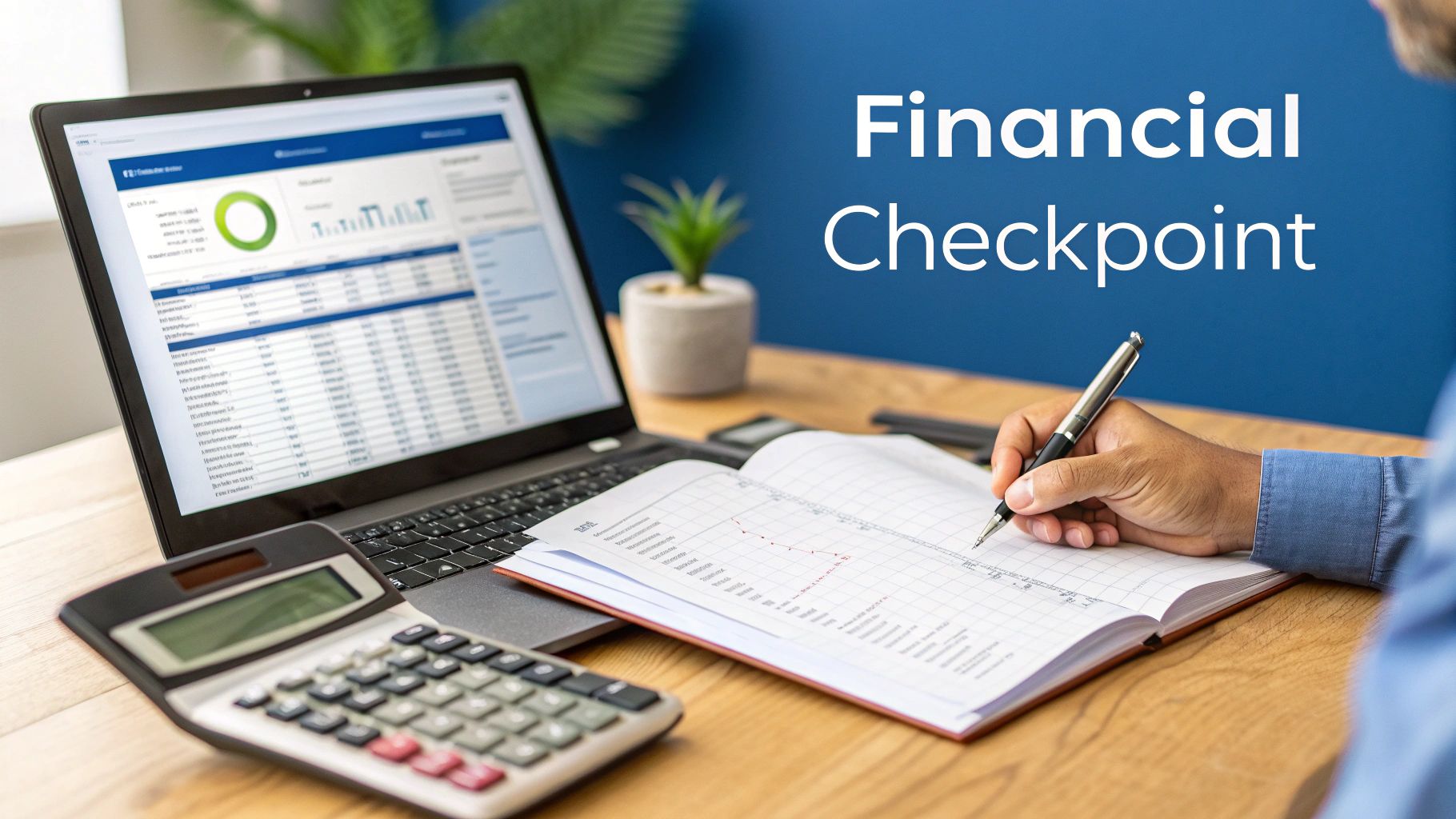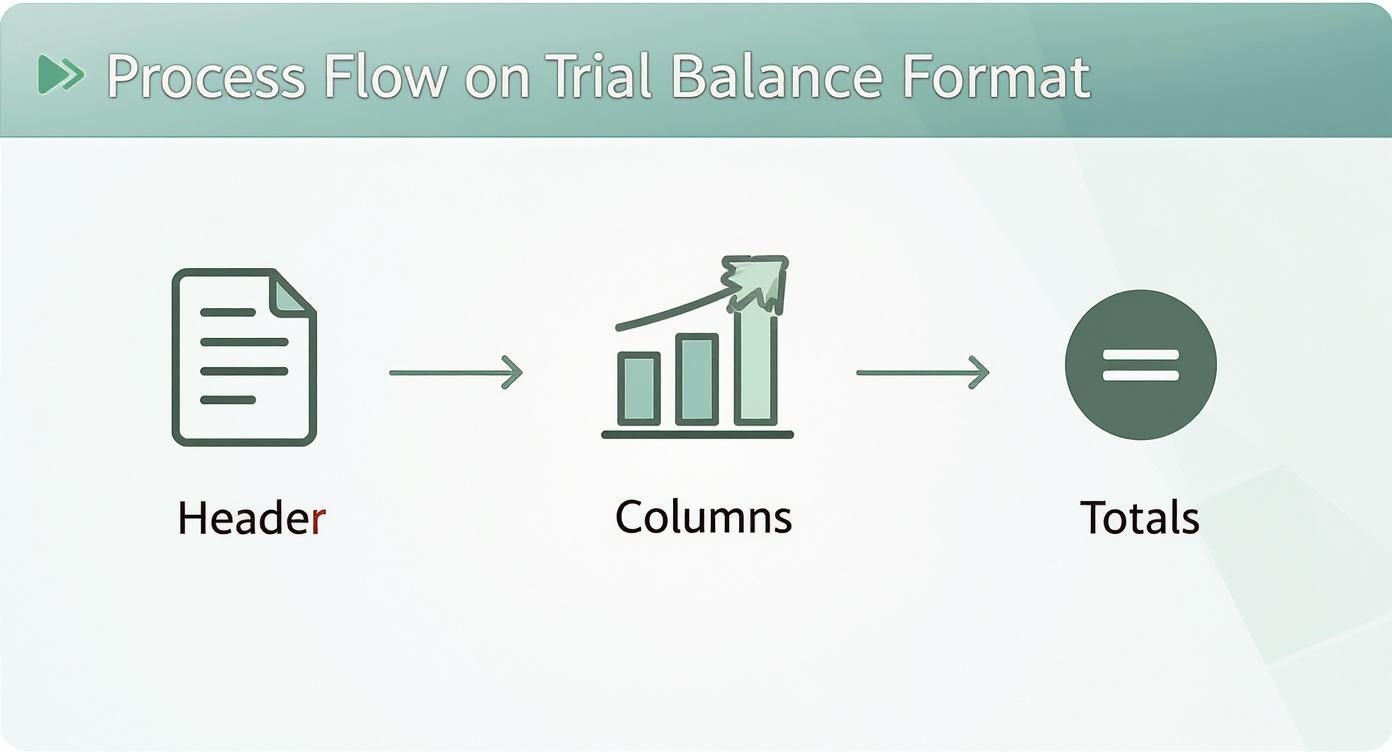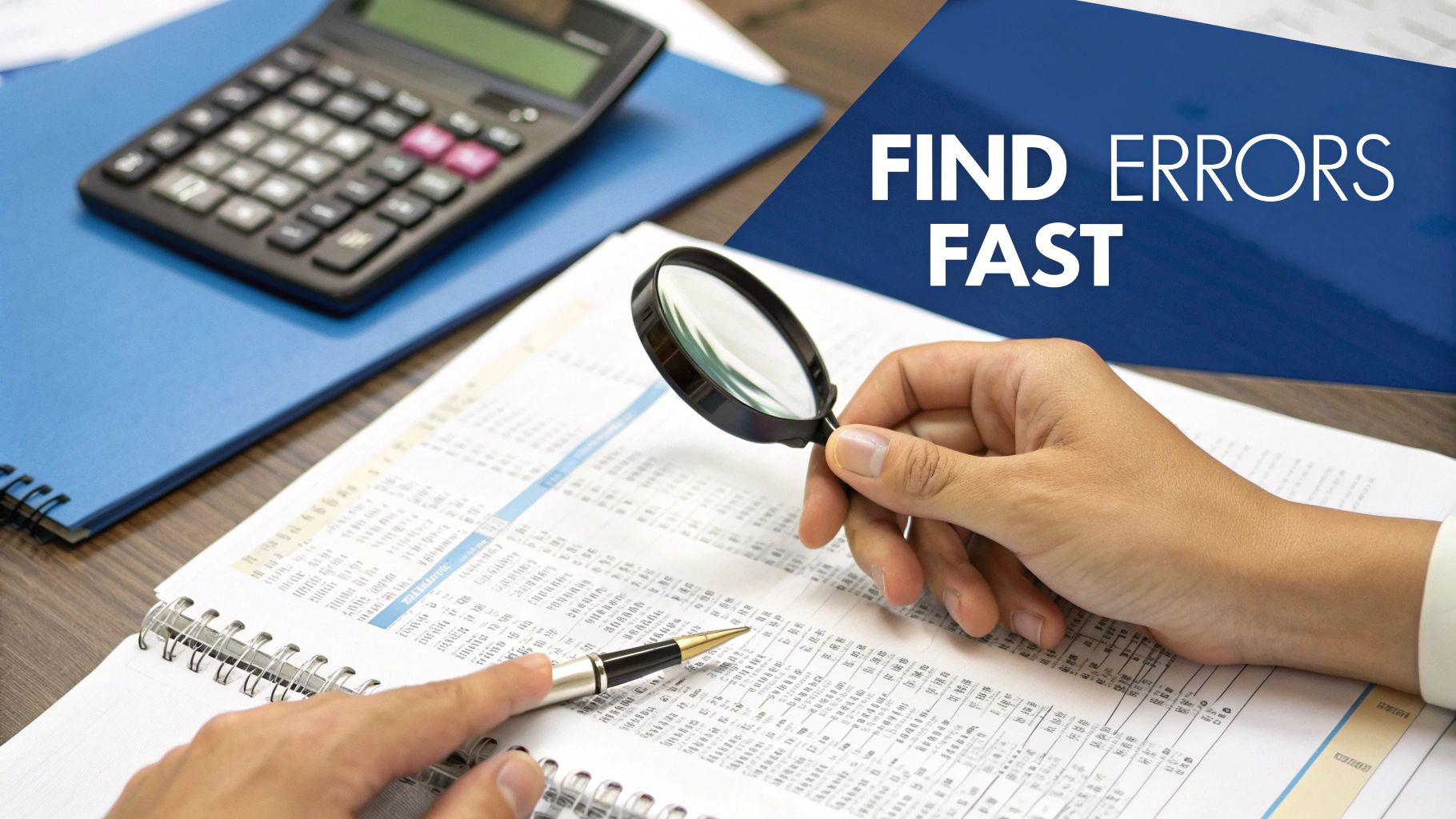
Mastering the Trial Balance Format
At its core, a trial balance is a straightforward list. It takes every single account from your general ledger and arranges them in one column, with their final balances sorted into two neighboring columns: one for debits and one for credits. The whole point of this exercise is to do a quick gut check and make sure the total of all your debits equals the total of all your credits—one of the golden rules of accounting.
Why the Trial Balance Is Your Financial Checkpoint

Think of the trial balance as accounting’s quality control station. It isn't a formal financial statement you'd send to a bank or investor, but rather an internal diagnostic tool for your own peace of mind. It’s the crucial bridge that connects the raw data from your day-to-day transaction entries to the polished, official reports like the income statement and balance sheet.
Before you can confidently generate those final reports, you have to know the numbers behind them are mathematically solid. The trial balance is built for exactly this purpose. It pulls the ending balance from every account you have and lines them all up for inspection.
The Power of Balance
The entire system of double-entry bookkeeping is built on one simple, unbreakable rule: for every transaction, the total debits must equal the total credits. The trial balance is your first real test to see if you've stuck to that rule.
If your debit and credit columns don't match, that’s an immediate red flag. It tells you there's a mistake hiding somewhere in your books. This simple but powerful concept has been the bedrock of accounting for centuries, first laid out by Luca Pacioli way back in 1494.
The trial balance is less of a report and more of a verification step. Its goal is to confirm the mathematical integrity of your ledger before you rely on that data for critical business decisions.
A Non-Negotiable Step for Accuracy
For any business that wants reliable financial data, running a trial balance is non-negotiable. It helps you catch errors early, stopping them before they can warp your financial statements and lead you to make bad decisions based on faulty numbers.
Understanding its purpose is the first step toward building trustworthy reports. This commitment to accuracy is a key part of mastering the bookkeeping basics for your small business. It lays a solid foundation for everything that comes next, from filing your taxes to pitching an investor.
Anatomy of the Standard Trial Balance Format
At first glance, a trial balance can look a lot like a simple spreadsheet. But its structure is carefully designed for clarity and efficiency. Think of it as a detailed roster for your company's money, where every account has its proper place. This standard trial balance format makes it incredibly easy to spot imbalances and get ready for the next steps in your accounting cycle.
The report always starts with a clear header. This top section names the company, states the report title ("Trial Balance"), and gives the exact date it was prepared for, like "As of December 31, 2023." This context is crucial because a trial balance is just a snapshot of your account balances at one specific moment.
The Core Columns Explained
Right below the header, you'll find the main body of the report, which is almost always organized into four essential columns. Each one plays a distinct role in double-checking the math in your general ledger.
- Account Number: This is the unique ID for each account listed in your Chart of Accounts. These numbers give you a systematic way to organize everything and find accounts in a flash.
- Account Name: Here you’ll find the simple, descriptive name of the account, like "Cash," "Accounts Payable," or "Sales Revenue." This makes the report readable for anyone, not just your accountant.
- Debit Column: This column lists the final balance for all accounts that naturally have a debit balance. This typically includes your assets (like Cash and Equipment) and your expenses (like Rent and Salaries).
- Credit Column: On the flip side, this column shows the final balance for all accounts that naturally carry a credit balance. These are usually your liabilities (like Loans), equity, and revenue accounts.
Another key feature is the logical order of the accounts. They aren't just thrown in randomly; the report follows the same sequence as your Chart of Accounts. If you want to get a better handle on setting this up, understanding why your chart of accounts matters is a fantastic place to start.
Putting It All Together: A Sample Format
To see how all these pieces fit together, let's look at a simplified example. This structure clearly lays out how assets and expenses land in the debit column, while liabilities, equity, and revenues are placed in the credit column.
Standard Trial Balance Format Example
| Account Number | Account Name | Debit ($) | Credit ($) |
|---|---|---|---|
| 1010 | Cash | 15,000 | |
| 1200 | Accounts Receivable | 5,000 | |
| 1500 | Equipment | 20,000 | |
| 2010 | Accounts Payable | 7,000 | |
| 3010 | Common Stock | 25,000 | |
| 4010 | Service Revenue | 10,000 | |
| 5010 | Rent Expense | 2,000 | |
| Totals | $42,000 | $42,000 |
The most important part of the entire trial balance format is that final totals line. After every account balance is listed, the debit and credit columns are summed up separately.
The ultimate goal is to see that the Total Debits line perfectly matches the Total Credits line. This equality confirms that your ledger is following the fundamental rules of double-entry bookkeeping.
When these two numbers match up, you’ve hit a crucial financial checkpoint. It means you can move forward and create your financial statements with a much higher degree of confidence.
Understanding the Three Types of Trial Balances
The trial balance isn't just a single report you pull once and forget about. It's more like a series of checkpoints you hit at different points in your accounting cycle. Each version gives you a unique snapshot of your financial data, helping you catch errors and ensure everything is on track.
In practice, there are three key types of trial balances you'll work with: the Unadjusted Trial Balance, the Adjusted Trial Balance, and the Post-Closing Trial Balance. Each one has a specific job, from giving your raw numbers a first look-over to making sure the books are squeaky clean for the next period.
The Unadjusted Trial Balance: The First Draft
Think of the unadjusted trial balance as the first rough draft of your financial story for the month or quarter. It’s a straightforward list of every general ledger account balance before any end-of-period tweaks are made.
The main goal here is simple: to make sure your debits equal your credits. It's the first test to see if the fundamental rule of double-entry bookkeeping has held up through all the daily transactions. If the totals don't match at this stage, you know an error slipped in somewhere, and you can start hunting for it before things get more complicated. For a refresher on the basics, check out our guide on how double-entry bookkeeping is explained.
The Adjusted Trial Balance: Polished and Accurate
Next up is the adjusted trial balance. You prepare this version after making all the necessary adjusting entries at the end of the accounting period. These adjustments are for all the financial activity that doesn't get captured in day-to-day transactions but is critical for getting an accurate picture.
Some of the most common adjusting entries you'll make include:
- Accrued Expenses: Costs you've incurred but haven't paid yet, like employee salaries earned in the last few days of the month.
- Accrued Revenues: Income you've earned but haven't invoiced or received cash for yet.
- Depreciation: Accounting for the wear and tear on your assets by spreading their cost over their useful life.
- Prepaid Expenses: Recognizing the portion of a prepaid cost (like a year's worth of insurance) that you've "used up" during the period.
The adjusted trial balance is where the magic happens. It gives you a much more complete and accurate view of your company's finances. This is the version you'll use to build your official income statement and balance sheet.
This infographic breaks down the simple, three-part structure you'll find in any trial balance, no matter which type it is.

This flow shows that every trial balance, at its core, is just a tool to prove that debits and credits are in perfect balance.
The Post-Closing Trial Balance: The Final Check
Last but not least, we have the post-closing trial balance. This one is prepared after you’ve made all your closing entries. Its whole purpose is to confirm that you’ve correctly zeroed out all your temporary accounts—like revenue, expenses, and dividends—and rolled their balances into Retained Earnings.
This final report will only list your permanent accounts: assets, liabilities, and equity. Think of it as the ultimate quality control check. It confirms your books are balanced and ready for a fresh start in the next accounting period, giving you a clean slate to begin a new financial cycle.
Finding and Fixing Common Accounting Errors

There’s a certain satisfaction that comes from seeing your trial balance’s debit and credit columns match perfectly. But while it’s a great first sign, a balanced report doesn’t automatically mean your books are flawless. It’s better to think of it as a first-level diagnostic tool—it’s brilliant at catching certain mathematical mistakes but completely blind to others.
The trial balance really shines at flagging discrepancies where debits and credits were recorded unequally. This makes it an incredibly powerful tool for catching simple but all-too-common human errors.
A balanced trial balance confirms mathematical equality, not absolute accuracy. It tells you that Debits = Credits is true, but it can’t tell you if the right numbers were used or if they were put in the right places.
Understanding what it can and can’t do is the key to using it effectively as a troubleshooting guide.
Errors Your Trial Balance Can Detect
The report is your best friend when it comes to identifying errors that throw the debit-credit equilibrium out of whack. If your totals don’t match, you likely have one of these issues hiding somewhere in your general ledger.
- Transposition Errors: This is a classic bookkeeping mistake where two digits in a number are accidentally swapped. For example, you record a payment of $81 when it should have been $18. The difference ($63) is always divisible by 9, which is a neat trick accountants use to spot this error quickly.
- Slide Errors: This is just a simple decimal point mistake. You might enter $10.00 as $100.00, or vice versa. The numbers are right, but they're in the wrong place value.
- Single-Sided Entries: This happens when a transaction was recorded with a debit but no corresponding credit (or the other way around). This breaks the fundamental rule of double-entry bookkeeping, and a trial balance will catch it every time.
When your columns don’t match up, the difference between the totals is often your first clue. A great first step in your investigation is to look for a transaction that equals that exact difference.
Errors That Slip Through the Cracks
Now for the tricky part. Even if your trial balance is perfectly balanced, your books could still have some significant errors. The report simply isn’t designed to catch mistakes that don't upset that fundamental debit-credit balance.
Here are some common errors that go completely undetected:
- Omitted Transactions: If a transaction was never recorded at all, your trial balance has no way of knowing it’s missing. The books still balance, but they're incomplete.
- Incorrect Account Classification: You might correctly debit and credit a $500 transaction, but you posted the debit to Office Supplies instead of Repair & Maintenance. The numbers add up, but your expense tracking is now wrong, which can throw off your budget and financial analysis.
- Duplicate Entries: Recording the same transaction twice will keep the books balanced, but it will also overstate your accounts.
Fixing an unbalanced trial balance just requires a methodical search. Start by simply re-adding the columns—sometimes it’s just a calculation error. If that doesn't work, check that the balances from your general ledger were transferred over correctly. From there, you can start tracing individual journal entries until you find the culprit and restore balance to your books.
Leveraging Your Trial Balance for Business Insights

While its main job is to prove your debits equal your credits, the trial balance format is hiding a lot more than a simple math check. For a savvy business owner, it’s a goldmine of strategic data. When you learn to look beyond the totals, you can turn this routine report into a powerful tool for managing your finances proactively.
Forget seeing it as just another end-of-the-month document. The real magic happens when you start comparing trial balances from different periods. This is where you uncover patterns and trends that would otherwise fly under the radar.
From Static Report to Strategic Tool
It all comes down to shifting your perspective. A single trial balance gives you a snapshot of where you are today. But a series of them? That tells the story of how you got here—and gives you clues about where you’re heading.
For instance, if your Accounts Receivable balance suddenly spikes over three months, it might be a red flag for your collections process. On the flip side, seeing a particular expense account steadily decrease could be the proof you need that your new cost-cutting measures are actually working.
This is exactly where a Trial Balance Monthly Trend Report comes in handy. In bigger companies, financial controllers live by these reports. They use them to monitor account fluctuations, which helps speed up the month-end close and improve its accuracy. By comparing this month's numbers to last month's, they can quickly spot big variances that might point to an error—or something worse—and make smarter decisions. You can see how experts use trial balance trend reports for analysis to get a better feel for it.
By tracking changes month-over-month, you move from reactive error-checking to proactive business analysis. This simple practice turns a standard accounting procedure into a forward-looking management tool.
Strengthening Internal Controls and Decision-Making
Regularly analyzing your trial balance trends does more than just give you insights; it strengthens your internal controls. Weird fluctuations or unexpected balances can be the canary in the coal mine, warning you of bigger problems. Catching these things early means you can investigate and fix them before they blow up your financial statements.
This deeper level of analysis empowers you to:
- Identify Emerging Trends: Spot rising costs or shifts in your revenue streams before they become a problem.
- Monitor Account Fluctuations: Keep a close eye on your most important accounts like cash, receivables, and payables.
- Improve Financial Health: Make informed choices based on a much clearer view of your company's performance over time.
Ultimately, this process transforms the trial balance from a simple compliance document into an essential part of your strategic toolkit. It helps you make smarter, data-driven decisions that will guide your business toward real, sustainable growth.
Common Questions About the Trial Balance Format
Once you start working with trial balances, a few practical questions almost always come up. These are the real-world sticking points people hit when moving from textbook theory to actual bookkeeping. Getting these sorted out is the key to using the trial balance format with confidence.
Here are the answers to some of the most common questions we hear. Think of it as your go-to guide for troubleshooting as you dig into your own financial data.
Is It Possible to Prepare Financial Statements Without a Trial Balance?
Technically, you could if your business is incredibly simple with just a handful of transactions, but it’s a terrible idea. The trial balance is your fundamental quality control check. It confirms that your debits and credits are mathematically equal before you go any further.
Skipping this step is like building a house without checking if the foundation is level. You dramatically increase the risk of major errors on your Income Statement and Balance Sheet, making them useless for filing taxes, getting a loan, or even just making smart business decisions. Thankfully, modern accounting software makes generating one an effortless, non-negotiable part of the process.
Your trial balance is a safety net. It catches imbalances early, stopping them from corrupting the financial statements you rely on to run your business.
What Is the Correct Order of Accounts in a Trial Balance?
The accounts on a trial balance aren't just thrown on there randomly. They follow a specific, logical order that mirrors your general ledger and chart of accounts, which makes building the final financial statements much, much easier.
The standard order is:
- Assets (Cash, Accounts Receivable, Equipment)
- Liabilities (Accounts Payable, Loans Payable)
- Equity (Common Stock, Retained Earnings)
- Revenue (Service Revenue, Sales)
- Expenses (Rent Expense, Salaries Expense)
This structure is all about efficiency. It groups all the balance sheet accounts (assets, liabilities, and equity) together right at the top. Then, it lists all the income statement accounts (revenue and expenses) below. This clean flow makes it simple to transfer the final numbers over to the correct reports.
Why Does My Trial Balance Match but My Bank Account Does Not?
This is a classic problem that trips a lot of people up. A balanced trial balance proves only one thing: that within your accounting software, total debits equal total credits. It doesn't verify that the transactions themselves are accurate or that they match outside records like your bank statement.
When your books don't match the bank, it's usually because of issues a trial balance isn't designed to catch, like:
- Omitted Transactions: A check you wrote or a deposit you made never got recorded in your books.
- Posting Errors: A transaction was entered for the right amount but posted to the wrong account (e.g., Office Supplies instead of Advertising).
- Timing Differences: This is the most common reason. Outstanding checks that haven't been cashed yet or deposits still processing will be in your books but not yet on the bank statement.
To fix these kinds of discrepancies, you have to perform a bank reconciliation. It's a separate, crucial process for making sure your cash balance is truly accurate.
How Do I Generate a Trial Balance in QuickBooks?
Good news—QuickBooks turns this into a simple, two-minute task. The software does all the heavy lifting by pulling the balances from your general ledger automatically.
Just navigate to the ‘Reports’ tab on your main dashboard. In the search bar, type "Trial Balance" and click on it. From there, you can set the date range for the period you want to review. QuickBooks will instantly generate the report in the standard trial balance format, with everything sorted into the proper debit and credit columns. You can then look it over right there or export it to Excel if you need to do more digging.
Feeling overwhelmed by debits, credits, and reconciliations? The expert team at Steingard Financial provides meticulous bookkeeping and payroll services to give you peace of mind and accurate financial data. Stop chasing down errors and start making confident business decisions by visiting us at https://www.steingardfinancial.com.





